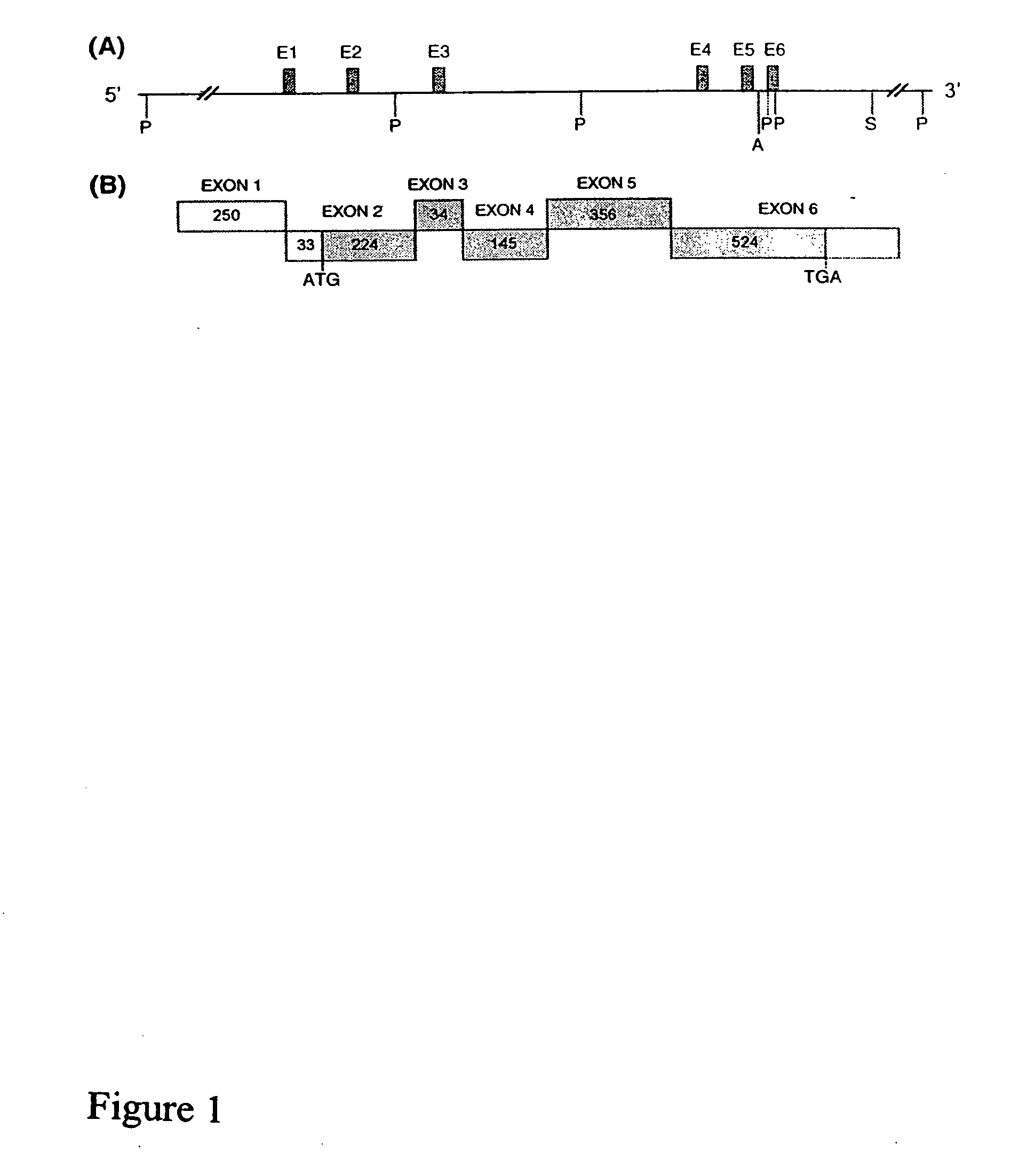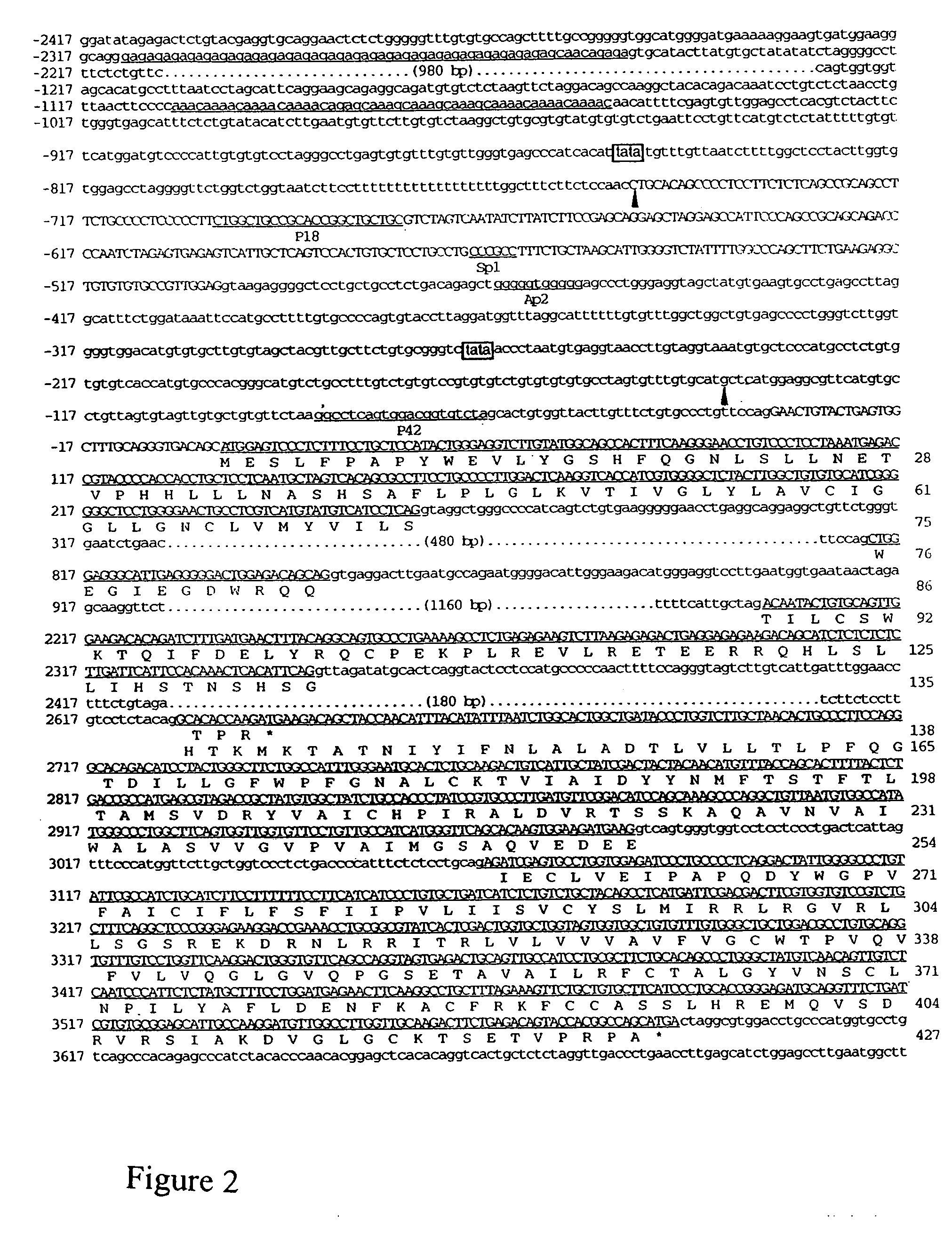Orphanin FQ receptor
a technology of orphanin and fq receptor, which is applied in the field of orphanin fq receptor nucleic acids and polypeptides, can solve the problem that the fqrs have a very low affinity for classical opioid ligands
- Summary
- Abstract
- Description
- Claims
- Application Information
AI Technical Summary
Benefits of technology
Problems solved by technology
Method used
Image
Examples
example 1
Isolation of OFQR Genomic Clones
[0231] This example describes the isolation of genomic clones from rat containing the OFQR. A rat genomic library in the bacteriophage EMBL-3 (Clontech) was screened as previously reported (Blandizzi et al., Biochem. Biophys. Res. Commun. 202: 947 [1994]), using a 32P-labeled cDNA fragment generated by the polymerase chain reaction (PCR) with primers based on the cDNA sequences of the rat OFQR (U01913, Bunzow et al., FEBS Lett. 347: 284 [1994]; and L29419, Wick et al., Brain Res. Mol. Brain Res. 27: 37 [1994]). Positive clones were digested with Pst I, Acc I, and Sac I. The resulting restriction fragments were subcloned into phage M13 mp18 or -mp19 and sequenced in both directions by the dideoxy chain termination method (Sanger et al., 1977) using the T7 Sequenase Kit (Amersham). Oligonucleotide primers for sequencing or for PCR were synthesized on a DNA synthesizer (Applied Biosystems-380B). Computer analysis of nucleotide sequences was performed wi...
example 2
Primer Extension Analysis
[0234] This Example describes the use of primer extension analysis to determine the putative transcription initiation sites of the OFQR gene. Primer extension was performed with poly (A)+ RNA (500 ng) from rat brain and colon combined with two end-labeled antisense oligonucletide primers: P18 (5′GCAGCAGCCGGTGCGGCAGCCAG3′; (SEQ ID NO:1) and P42 (5′TAGACACCGTCCACTGAGGCC3′; SEQ ID NO:2), as previously described (Muraoka et al., Am. J. Physiol. 271:G1101 [1996]). FIG. 2 shows the location of the primers (exon 1 and intron 1, respectively).
[0235] When the end-labeled primer P18 was used in the extension reaction, an elongation product of 72 bp was detected in both brain and colon, and the transcription initiation site was identified as the cytosine 103 bp downstream from the TATA box at nt 750 in the 5′ flanking region (FIG. 3A). In contrast, when primer P42 was used, an elongation product of 71 bp was detected in brain tissue only, and the transcription initia...
example 3
PCR Cloning of Gene Splice Variants
[0236] PCR cloning was performed with poly (A)+ RNA (150 ng) from rat brain, colon, and liver using strategically designed oligonucleotide primers (Table 1), as previously reported (Song et al., Proc. Natl. Acad. Sci. USA. 90, 9085 [1993]). Primer P13 (SEQ ID NO:7) in the 3′ untranslated region was used in combination with either primer P9 (SEQ ID NO:6) in exon 1 or primer P3 (SEQ ID NO:3) in intron 1 to produce full-length cDNAs. Primer P3 containing the 20-mer of intron 1 sequence was designed to verify splice variants that did not express exon 1. The resulting PCR products served as the templates for subsequent PCRs using internal primers P5 (SEQ ID NO:4) and P10 (SEQ ID NO:5). Gene splice variants were identified by sequencing as described above.
[0237] When primers P9 and P13 followed by primers P5 and P10 were used for PCR, multiple bands were obtained from the brain and colon RNA (FIG. 4A), rather than the expected single band. Using primer...
PUM
| Property | Measurement | Unit |
|---|---|---|
| Therapeutic | aaaaa | aaaaa |
Abstract
Description
Claims
Application Information
 Login to View More
Login to View More - R&D
- Intellectual Property
- Life Sciences
- Materials
- Tech Scout
- Unparalleled Data Quality
- Higher Quality Content
- 60% Fewer Hallucinations
Browse by: Latest US Patents, China's latest patents, Technical Efficacy Thesaurus, Application Domain, Technology Topic, Popular Technical Reports.
© 2025 PatSnap. All rights reserved.Legal|Privacy policy|Modern Slavery Act Transparency Statement|Sitemap|About US| Contact US: help@patsnap.com



